We explored the beautiful Costa Blanca in a special way - by tram. The route took us from El Campello, past the picturesque alleyways of Altea, to the lively city of Alicante. Each stop offered us a new facet of the coast, from the colourful houses of Vila Joiosa to Benidorm. The tram journey along the breathtaking coast is not only an environmentally conscious and affordable way to travel, but also an opportunity to experience the diversity of this region in all its colours and moods.
By: Gate to Paradise | Published: January 3, 2025 | Last Updated: June 11, 2025 | Jump to Comments
How to get around
To explore the Costa Blanca, you basically only need the 2 tram lines L1 and L9. These will take you from Alicante to Denia. Depending on the route, you move between zones A, B and C. Ticket prices depend on the distance you travel, but are very moderate compared to other cities.
where can i buy tickets?
As Swiss, we are used to finding a ticket machine at every large and small stop. On the Costa Blanca, however, things are a little different, which doesn’t mean that it’s bad. Here it is common to only find a ticket machine at large stops.
We would not recommend buying via the website, as it is confusing and there are many dubious platforms in addition to the official ones.
But if you like to check it out, here is a lik to the official website: Tram Alacant
TIP: On the Costa Blanca you will find at least 1 ticket machine in every streetcar. These are usually located at the very front and very back of the streetcar. This is a super efficient solution. Of course, you can also pay contactless with a credit card.
1. El Campello
El Campello is a treasure on the Costa Blanca – a coastal town that tends to be overshadowed by the better-known hotspots on the Costa Blanca – and that’s what makes it so special in our opinion. This is where we found our Airbnb, surrounded by a relaxed atmosphere, a beautiful beach and delicious restaurants. The picturesque harbor is the heart of El Campello and offers you an insight into the local fishing industry.
El Campello is definitely a good starting point to discover the area by tram. The tram lines are very well organized and you can hop on at El Campello’s tram station and relax during the train ride along the coast.
TIP: If you want to experience a journey back in time to ancient times, you should visit the Roman ruins of La Illeta dels Banyets on a small headland in El Campello.
2. Vila Joiosa
Vila Joiosa, also known as “La Vila”, is an absolute gem on the Costa Blanca and a must-see place. Even the first glance at the colorful houses along the beach promenade makes your heart beat faster. These brightly painted façades, which used to help fishermen see their homes from the sea, give the village a unique charm and vibrancy. It feels like every corner is a great photo opportunity.
La Vila not only has a lot to offer visually, but also a rich history. The narrow alleyways lead to the remains of the old city walls that once protected against pirate attacks. And for those of us with a sweet tooth, the famous Valor chocolate factory is located here and shows you the tradition of Spanish chocolate up close.
The reason why this place has taken our hearts by storm is definitely the contrast between tranquillity and liveliness. While you can enjoy the sun and the beautiful sea on the beach, the village is full of life and culture. A village that has captivated our souls with its beauty, history and authenticity.
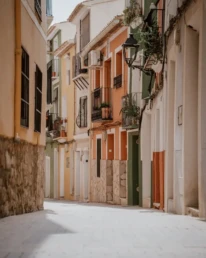
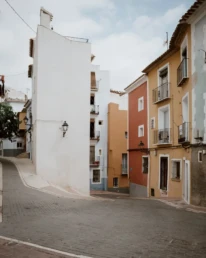
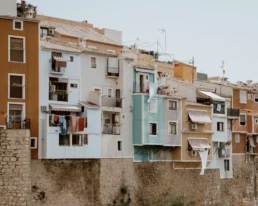
3. Benidorm
The city that is known as the “Manhattan of the Mediterranean” – with its skyscrapers lining the beach, Benidorm offers an image that is very different from the charming, traditional villages of the region. While visitors appreciate the vibrant energy, countless bars and nightlife, the city didn’t really captivate us. Benidorm seemed hectic and overloaded with tourists – which has long since lost its originality. Although the beaches are impressively large and the sea is clear, the atmosphere reminded us more of an urban tourist center than the authentic Spain we were looking for on our trip. The feeling of mass tourism and the densely packed high-rise buildings detracted from the Mediterranean flair that we usually appreciate in Spain.
For the party animals among us who are looking for the hustle and bustle, Benidorm may be the right place and can certainly be worth a visit – because Benidorm definitely shows a different side of the Costa Blanca.
4. Altea
Altea is undoubtedly an enchanting village on the Costa Blanca. The famous blue dome of the Catholic church of Nuestra Señora del Consuelo, which towers proudly over the village, is just the beginning of the charm that this picturesque village exudes.
In the alleyways around the aforementioned church, you quickly feel transported back in time. The cobbled streets wind their way gently up the hill, with breathtaking views of the sparkling Mediterranean Sea opening up at every bend.
The Mediterranean flair around Altea’s landmark, the Plaza de la Iglesia, is palpable and invites you to relax and enjoy the alleyways – as it is not (yet) overrun by mass tourism.
Altea is a mecca for art and culture lovers, here you will find numerous galleries and craft stores that reflect the creative atmosphere of the town. After a relaxed tour of discovery, the waterfront promenade invites you to end the day with a glass of Spanish wine. Altea definitely has something magical about it and is a real insider tip.
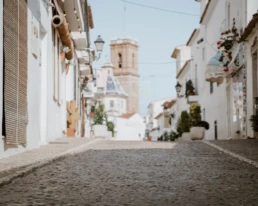
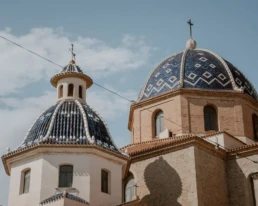

5. Alicante
The vibrant capital of the Costa Blanca is a lively coastal city that combines modern and historical treasures. And don’t forget the picturesque beaches. On the way to the most famous landmark, the Castillo de Santa Bárbara fortress, you will discover the beautiful alleyway El Barrio de Santa Cruz. An absolute must-see in Alicante – a street that will captivate you with its flair and colorful charm. This district comes to life especially at night, when the tapas bars and restaurants open their doors and invite you to enjoy Spanish delicacies.
The Esplanada d’Espanya is one of the most famous promenades in Spain. With its curved marble mosaics that reflect the wave pattern of the sea, it invites you to stroll under the palm trees. Here you will find many restaurants and market stalls. It is also impressive to observe the balancing act between modern and traditional at the harbor next to the promenade – from the yachts to the fishing boats.
To relax, we recommend the Playa del Postiguet beach, which is right next to the town center. Ideal for a break after your sightseeing tour.
TIP: For fun, you can stroll through Mushroom Street (Calle de Las Setas) and discover the numerous, large mushrooms that will make your walk unforgettable.
Alicante is a city full of contrasts, lively city life on relaxed beach days.
Our tram journey through the Costa Blanca was definitely more relaxing than we had previously imagined. You can practically travel along the entire coast in two trams and have a breathtaking view to boot – highly recommended.
I am text block. Click edit button to change this text. Lorem ipsum dolor sit amet, consectetur adipiscing elit. Ut elit tellus, luctus nec ullamcorper mattis, pulvinar dapibus leo.

